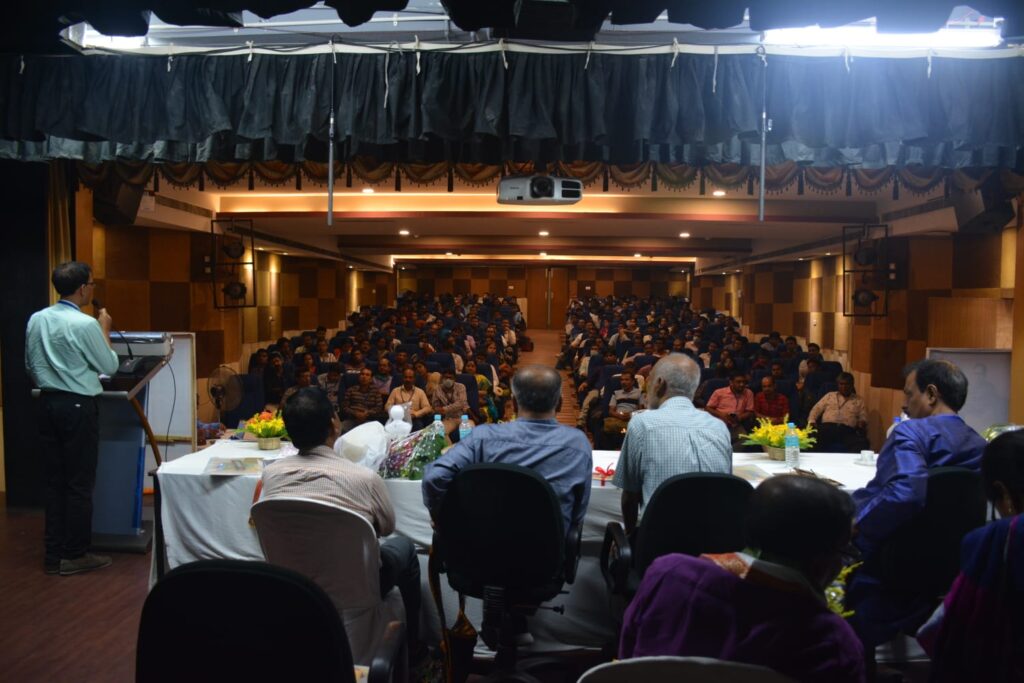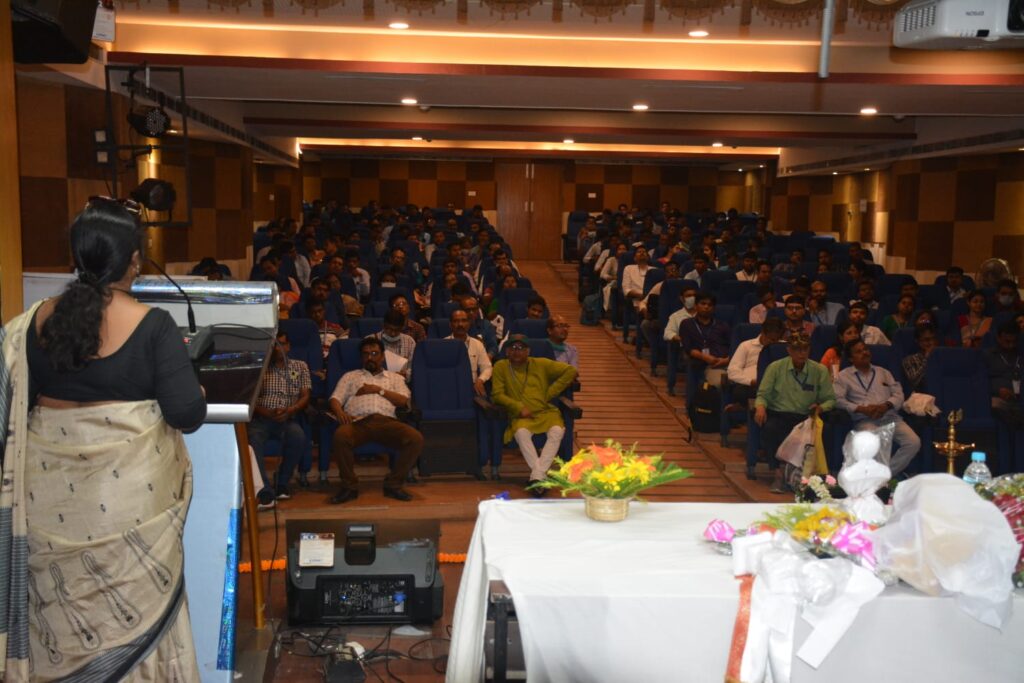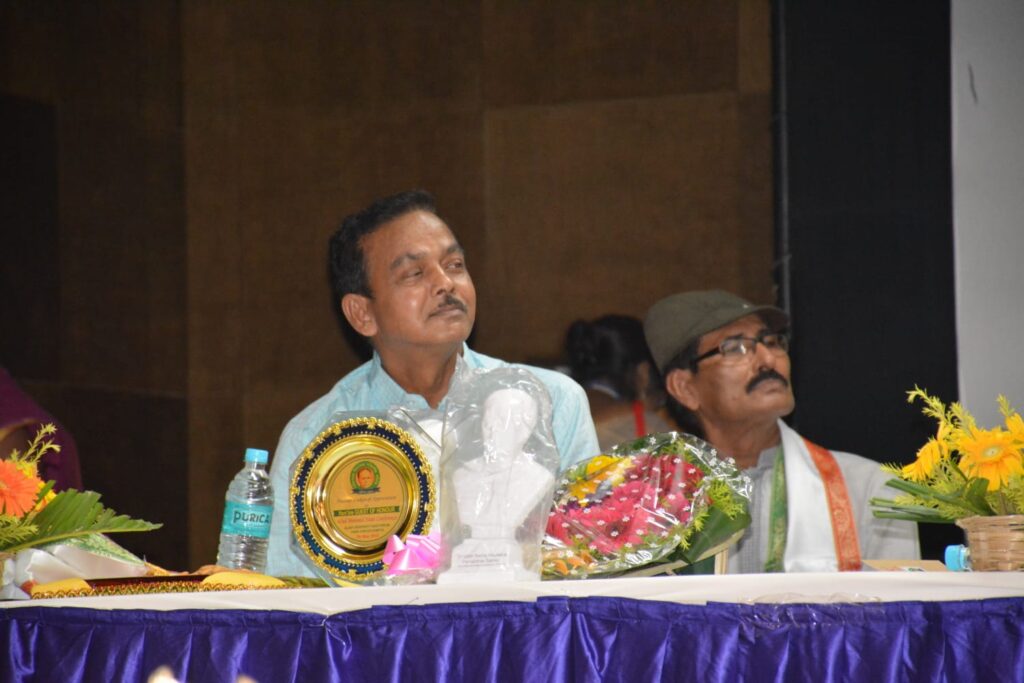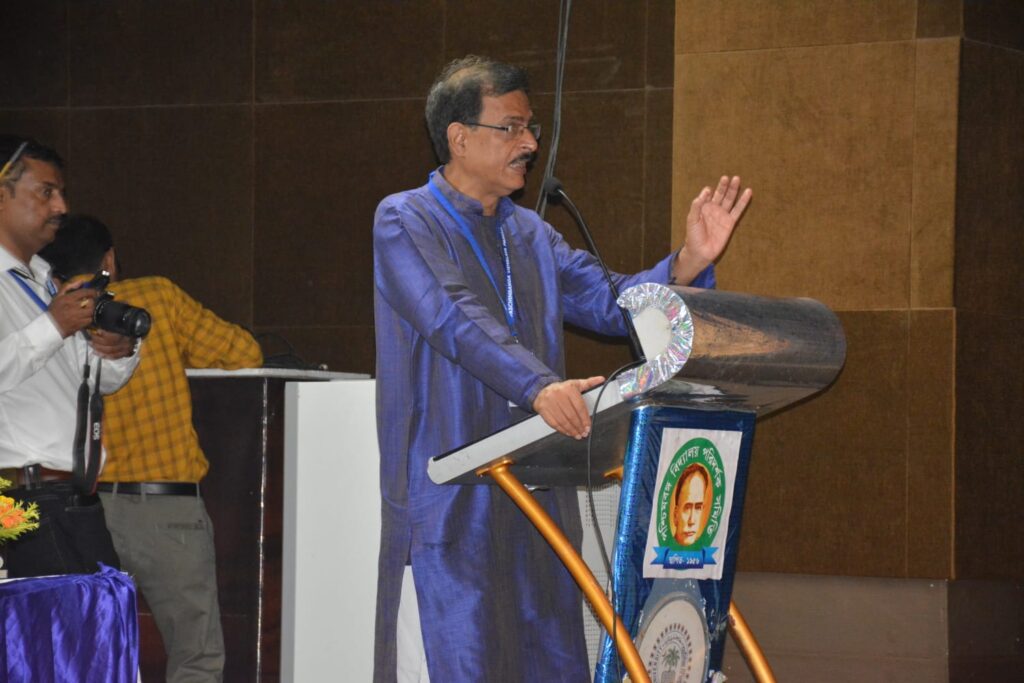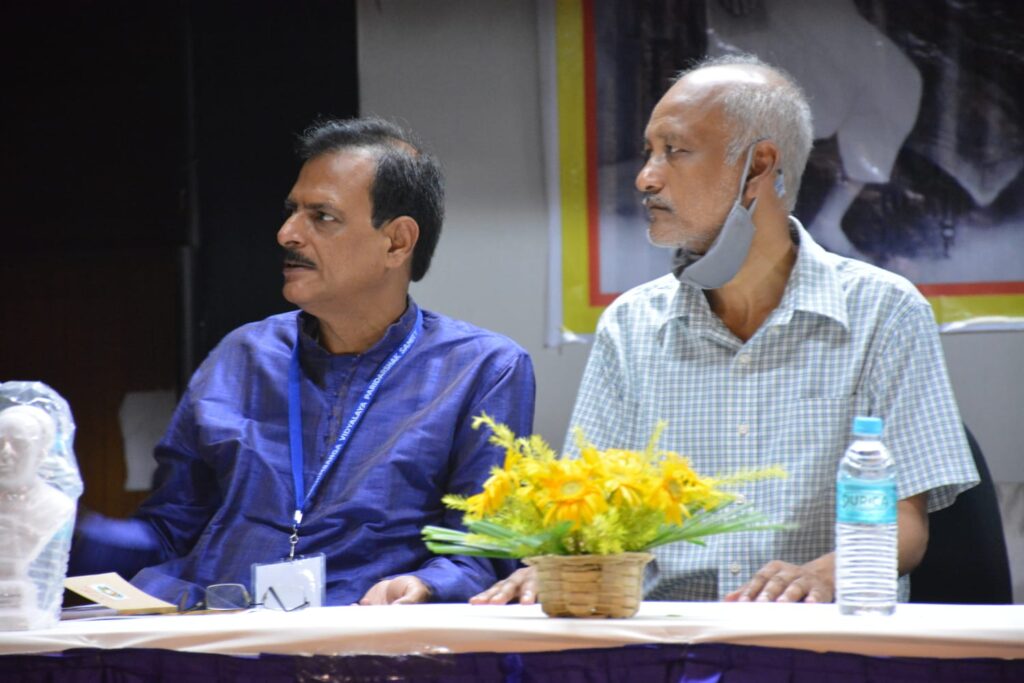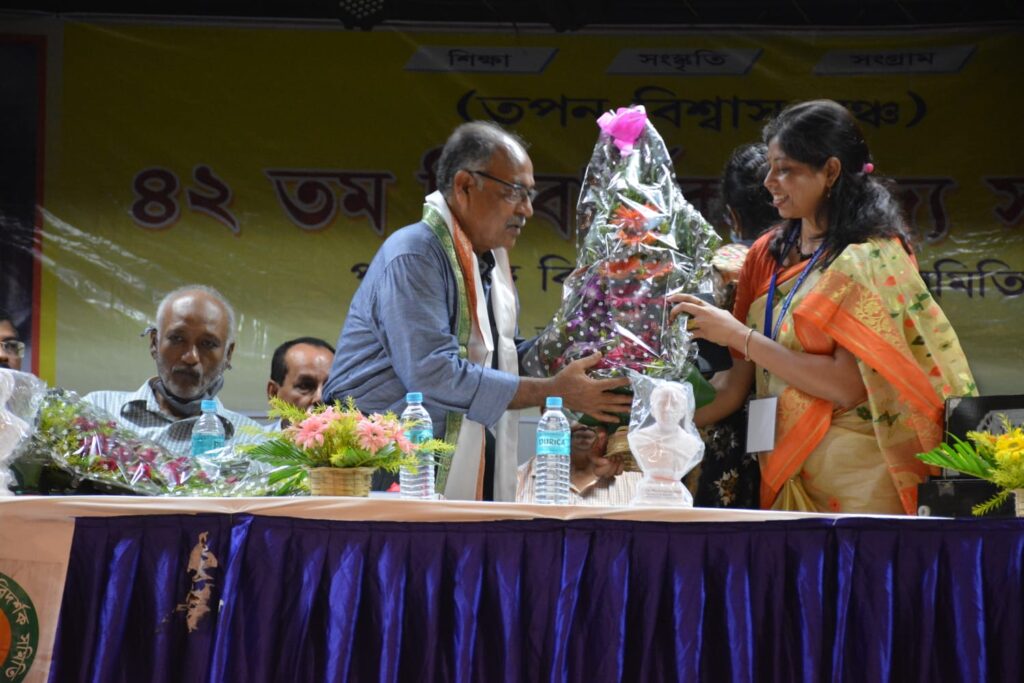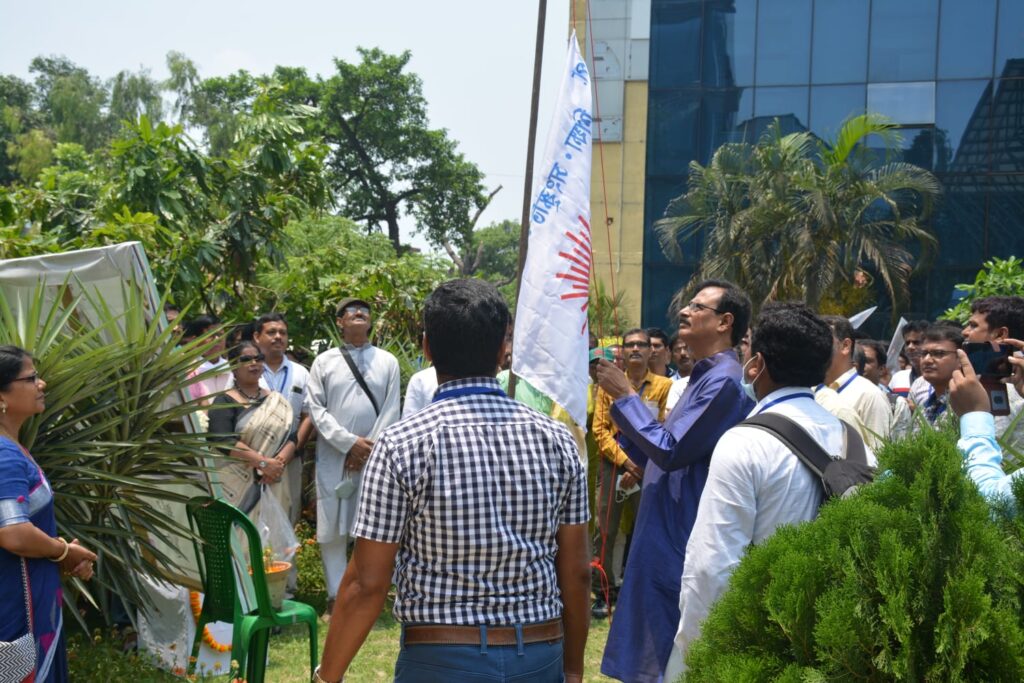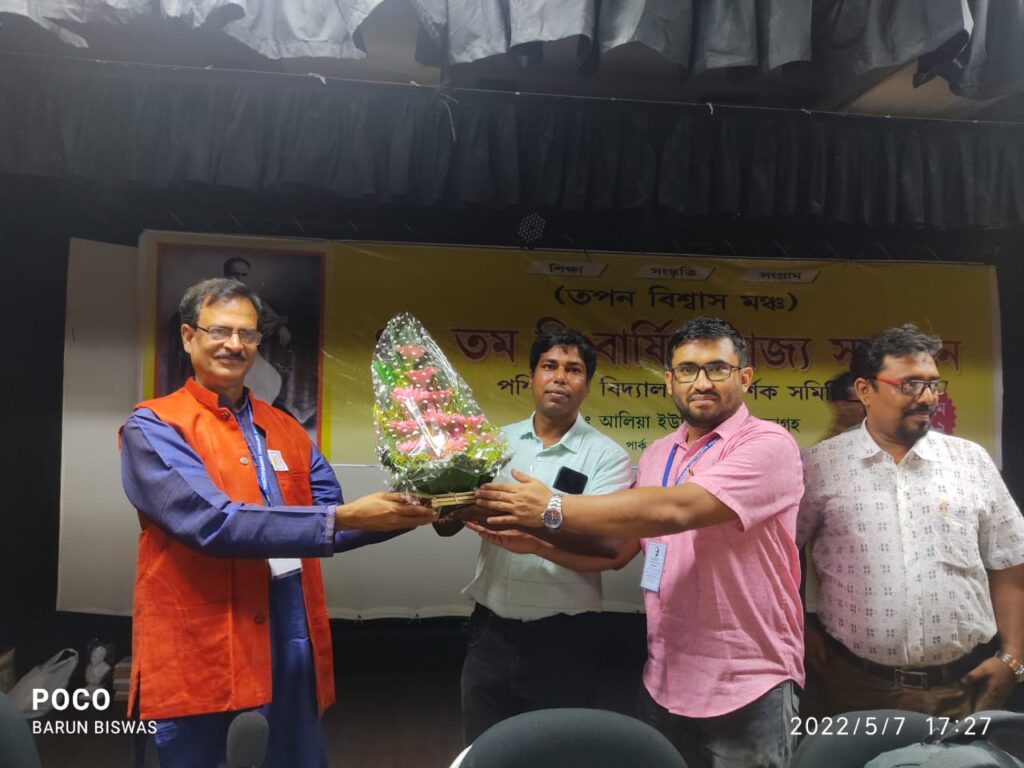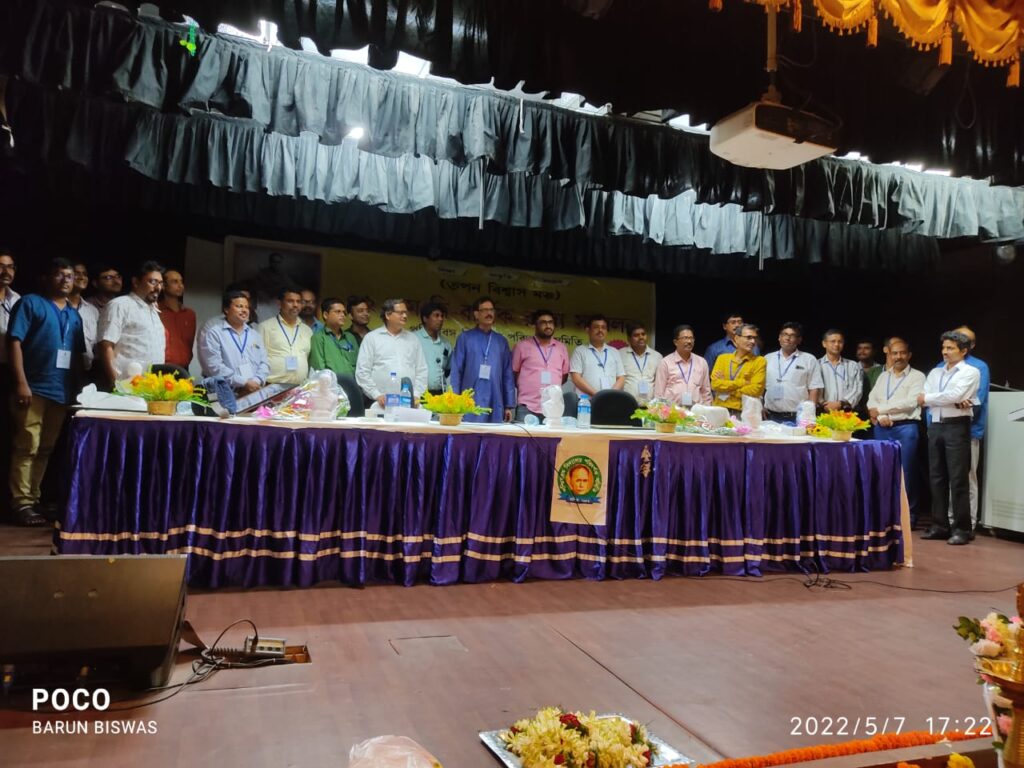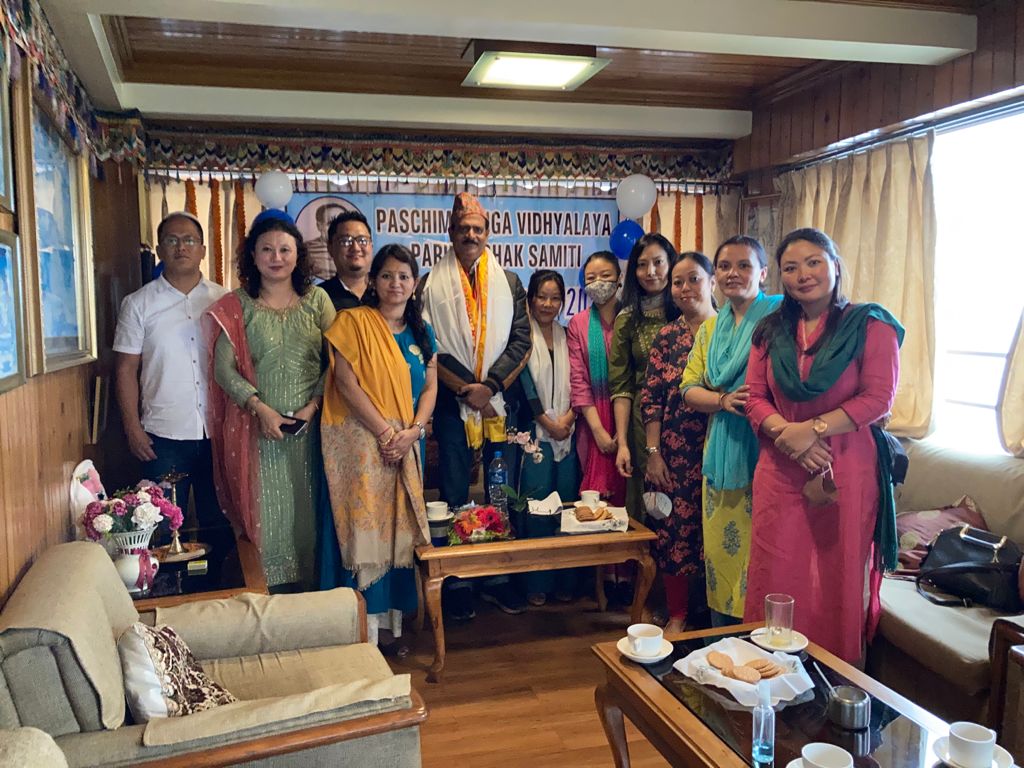Paschim Banga Vidyalaya Paridarshak Samity : Some old words (History of P.B.V.P.S.)
Before Independence: Situation of School Inspectors
History of P.B.V.P.S. is not easy to describe with few words. History of P.B.V.P.S. as well as the cadre of School Inspectors is very interesting.
The Bengal Education Code of 1930 was designed to steer the Indian education system in a certain direction, leading to radical reforms in educational administration. There is a need to form an official class to manage the Indian education system. In this situation in 1940 West Bengal Education Service Rule, Appointment Rule, Work Chart, Work Distribution rules were made. An education service cadre called West Bengal Subordinate Education Service is created.
Several SI of Schools posts are created, and their recruitment process completed. At that time one SI of Schools was working for each police station area and in many cases two or three police stations areas. However, despite belonging to the same cadre, the School Inspectors had almost no communication among themselves. As a result, many times the general school inspectors had to be victims of various injustices by the higher officials or Chief Inspectors. As a result, there was a need for school inspectors to organize themselves since the 1940s.
In India under British rule the organization of workers or meetings was completely illegal. As a result, even though there was injustice, it was not possible to hold a meeting in committee for fear of falling under the service conduct rule. The country became independent in 1947. In 1950, India became a People’s Republic and held general elections in 1952. Dr. Bidhan Chandra Roy, the Bharat Ratna of Bengal, took charge as the Chief Minister of West Bengal. After assuming charge, he decided to form a committee to conduct a survey across the state to investigate the educational and industrial possibilities in the state. The responsibility of conducting this survey is assigned to school inspectors, especially SI of Schools.
After Independence: Formation of first Paridarshak Samity
Meanwhile, since the 1950s or later, school inspectors have been trying to organize themselves by keeping in touch with each other. On this occasion the then SI of Schools of Bhangar Ram Renu Mukherjee Mahashay invited some well-known school inspector colleagues to his house on the day of Saraswati Puja in 1955 for discussion regarding objective of the formation of association. On that day, it was decided among themselves to form an association of school inspectors. With this objective in mind a meeting was convened the following year on 21 February 1956 at Banipur in the then undivided 24 Parganas district. There ten school inspectors came together to form a committee and completed preliminary discussions.
It was not possible to reach the message to all the school inspectors across the state and it was not possible to bring all the school inspectors together at one place. Suddenly, in late 1956, that opportunity came to the inspectorate. A survey training has been arranged for all the school inspectors of the whole state under the government management.
Formation of first Ad-hoc Committee:
Three days Education Survey Training at Presidency College in late December 1956. A three-day training was organized under the supervision of the State Statistical Bureau. Theoretical training in the first half, Field Survey in the second half. At that time the number of posts of SI of Schools sanctioned in the whole state is about 300. After the second day of training, all the school inspectors in training (183 in number) assembled at the Presidency College grounds. A history has begun in the field of School Inspectors of Bengal.
The first meeting of school inspectors was held in the Presidency College grounds in the presence of 183 members. The initial discussion is to form an Association of School Inspectors, a committee will be formed for this purpose. As the discussion on the first day was very fruitful, it was decided to organize another meeting on the next day and formed an ad-hoc committee for the next six months. This committee will carry out the primary tasks of the association such as drafting the constitution, making rules for the members etc. On the second day, the first ad hoc committee of the association was formed.
This committee was in this form:
President – Ajit Halder
Vice President – Rishikesh Das Adhikari
Secretary – Ramrenu Mukhopadhyay
Treasurer – Prafulla Biswas
Accountant – Anil Sarkar
Goal or Purpose of the Association:
At the time of birth, the goal or purpose of the society was like this:
(1) Security and Service Upliftment of all School Inspectors.
(2) To protest the unjust injustice of higher authorities, to build resistance.
(3) Creating an enabling environment for rural development in the state.
Society Registration:
The association was formed but the members were afraid that if the news of this organization came to the attention of the higher authorities, they would have to face any new danger under the service conduct rule. In this regard, the members consciously concluded that the association wanted to have trade union rights to continue negotiations with the Government or to organize agitations. At that time Chief Inspector Shri Hriday Ranjan Ghoshal, who was sympathetic to School Inspectors, was consulted and he said that the Government would not give this right to School Inspectors. If the trade union is not recognized there are legal problems for the members to unite or meet. Any time service conduct rules, the possibility of danger remains. In this situation, it was decided that the society will be registered as per the Society Registration Act of 1860 of the Government of India. Accordingly, the minimum demand certificate was prepared and the work of registration of the society started. Application for registration of society submitted in the year 1960 (19-02-1960).
Association of the Officers of West Bengal Subordinate Educational Service Inspection Branch:
Then came that historic day. Registration of the Society was completed on 4th August 1960. There was no longer any legal bar to the School Inspectors to aggregating their claims. The name of the association was “Association of the Officers of West Bengal Subordinate Educational Service Inspection Branch”. Address of the Society was 39, Kasundia Road, Howrah; At the home address of Ramrenu Mukhopadhyay, general secretary of the association. This was the address of the association till 1968.
When an association of school inspectors was formed in 1956, there was no organization of government officers in the state. So, it is a traditional organization in terms of antiquity. At the time of its inception, the association was pitched as a cultural organization to keep it free from legal entanglements. For that purpose, since then a monthly mouthpiece of the association called “Education and Visitation” was published. Monthly subscription of members was 25 paise and at least one annual general meeting was organized every year. For the first 25 years of the association, annual state conferences were organized. But one year for increasing membership and conducting various activities of the association is not enough, so it was decided in the silver jubilee year of the association to organize biennial state conferences thereafter.
In this association formed for the sake of creating a work environment and social development to protect their unity and solidarity, their disunity has come to the fore again and again and later everyone came together under the umbrella of the association and participated in the fight to realize the common demands of the school inspectors.
Tough Challenges of the beginning:
The association was formed, the association had to face tough challenges in the beginning. When it started to organize itself, and try to present its own statement through discussion with the authorities, that is, within one year of the formation of the association, the association had to face the most hostile situation in the history of the Cadre. In 1958 there was a state level meeting of District Inspectors of Schools. The Education Secretary said in that meeting that in the next pay committee, the salary structure of school inspectors will be determined according to their educational qualifications like high school teachers. Graduate and Post Graduate degree holders will also be given preference for promotion. None of the persons participating in the discussion raised any objection against it nor were they given an opportunity to discuss it. Realizing that inspectors were uniting, higher bureaucrats began to adopt traditional methods. In order to break the unity of the inspectors, an attempt has been made to create a separate pay structure for general graduate and honours graduate, post graduate inspectors, with the aim that the inspectors will be divided into at least two parts. The high-ranking bureaucrats will also be able to run the office without any protest or resistance. This is the beginning. ………….
As a result of such opinion expressed by the Education Secretary, an atmosphere of unrest was created among school inspectors across the state, which was bound to affect the salary structure of school inspectors as well as create an atmosphere of disunity among themselves. Therefore, to get a solution against this order, the association decided to initially try to find a solution through an application with the higher authorities, and if no solution is found, the law will be resorted to.
Introduction of G.O. No. - 7754 - Edn (A) Dated, 20 / 21 July 1958: New Pay Structure as per Qualification:
The Education Secretary at that time was Dhirendra Mohan Sen, who simultaneously held the additional responsibilities of Education Secretary and Director of Education. He was so influential that he ignored the instructions of the Education Minister and ran the office of his own volition. As a result, there was no opportunity to discuss with the Education Secretary or Education Director. In this situation, one of the leaders of the association conveyed the message of the association to Education Minister Harendra Kumar Chowdhury through a legislator known to him in the assembly. Honourable Minister assured that he will make necessary recommendations to the Pay Committee. But practically ignoring the recommendation of the Education Minister, the Education Secretary recommended fixing the pay structure against the interests of School Inspectors. Similarly, according to GO No 7754 Edn (A) Date 20 / 21 July 1958, the pay structure of school inspectors has been fixed according to qualifications since 1958.
The pay structure is as follows –
BA, BT-100-225,
MA, BT-130-350,
This order is vide Memo No 7754-Edn Date 20 / 21-07-1959
Minimum qualification for recruitment to the post of Sub Inspector of schools has been fixed as
- Honours Graduate Or Second class master degree with diploma or degree in teaching in the scale of pay 130-5-150-10-350.
- Scale of Graduate with diploma or degree in teaching experience: 100-225.
File of Writ No 253 / W of 1962 against G.O. No. - 7754 - Edn (A) Dated, 20 / 21 July 1958:
In this situation, in 1959, 9 SI of Schools filed a case in the High Court against the salary structure according to qualification. The case was conducted by the initiative of the association with the financial support of all the members. SI of Schools Kuloda Chakraborty’s father assisted as advocate in this case.
When the report of the Pay Committee was published in 1962, it was found that the School Inspectors were facing huge financial losses, so the association decided to resort to the law directly. A sub-committee was formed under the chairmanship of association president Rishikesh Das Adhikari. At that time the cooperation of famous lawyer Siddharth Shankar Roy was sought. A case was filed in the Calcutta High Court in May 1962 appointing Siddhartha Shankar Roy as a lawyer (Writ No 253 / W of 1962). A show cause notice is issued to the departmental authority as per Article 226 of the Constitution. The case dragged on for a long time. Two and a half years after the case was filed. The hearing was held in late 1964 and the verdict was delivered in October 1964. The judgment said that there should be no discrimination in pay between graduates and post-graduates who are appointed as SI of Schools based on the same advertisement and who perform the same job. Despite the court order, this discriminatory pay structure remained in place. A few high-ranking officials of the Education Department were standing in the way of implementing this order for personal benefits and for their own self-interest from the close circle of the Education Secretary as the Education Secretary’s custodians and were delaying the implementation of this order for various reasons.
When the association applied for Contempt of Court as the authorities did not implement this order, the authorities gave an affidavit in the Hon’ble High Court stating that all SI of Schools will be paid in the fixed salary structure as ordinary graduates. As a result, the demand for higher salary was cancelled and the authorities were cleared of Contempt of Court charges. The order in this regard is in this form : Office of the A/G No. Edn-11/520 : Minimum qualification for recruitment to the post of Sub Inspector of Schools as fixed as Honours Graduate Or Second class master degree has been withdrawn with effect from 29/10/1964. The affidavit given by the authorities in the High Court in the case of the year 1962, that those who are paid at a higher rate, it was given to be recovered but later on it was waived in another order.
Introduction of G.O. No. 3376 / Edn Dated, 29-10-1964: New Salary Structure of SI of Schools:
Salary structure of SI of Schools has been revised by issuing a new order. According to G.O. No 3376 / Edn Dated 29-10-1964, the authorities issued the order.
The new pay structure stands as follows :- (175-325).
The order in this regard is in this form :-
Memo No-3376 – Edn Dated: 29 10-1964: Recruitment qualification of Sub Inspector of Schools has been fixed as graduation only and scale of pay as fixed at 175-7-245-8-350.
Hon’ble Siddhartha Shankar Roy advised the Society to appeal against this judgment. But as those who looked after the cases in Calcutta were not zealous, no further appeals were made. Another source said that at that time Siddhartha Shankar Roy was out of Calcutta and this form of apprehension was expressed by the authorities that the Inspectors who were staying near Calcutta, who looked after the cases, would be transferred out. As a result, there was no further appeal.
Creation of post of Deputy Assistant Inspector of Schools: G.O. No. 2018-Edn (A) Dated, 16-04-1965
In 1958, the government issued guidelines for determining pay scales according to qualifications. It is proposed to make separate pay structure for ordinary graduate and inspectors with honors graduate or post graduate degree. The association opposes it. Because it would create different classes among the inspectors, thereby leaving the possibility of disrupting the harmony of the inspectors. The bureaucratic advantage of the inspectorate if the inspectorate is separated. The association formed out of the need for a concerted movement against bureaucratic injustice will not last long. Leaving the possibility of future bureaucratic downfalls in the inspectorate in various ways.
From 1959 to 1965, it was being said by the higher authorities that a salary structure should be fixed according to qualifications to attract highly educated people to the inspection branch. In 1959 the Pay Committee’s report laid down the pay structure according to merit and the society approached the law. In October 1964 the judgment of the Hon’ble High Court went in favor of the society. The higher government bureaucrats could not accept this loss. So, an alternative method was tried to damage the cadre of School Inspectors. Therefore, as this plan was not implemented, by 1965 a new post was created to divide the unity of Inspectors. Deputy Assistant Inspector of Schools, only School Inspectors with honours graduation and post graduation degrees will be appointed to this post. (G.O. No. 2018-Edn dated, 15-04-1965 and with effect from 01-04-1965)
As per G.O. No. 2018- Edn (A) Date 16-04-1965 a new post was created with effect from 01-04-1965 – Deputy AI of Schools. Deputy AI of Schools is a post in which the SI of Schools with Honours Graduate and Post Graduate degree can come to the position. But later will not get promotion as Assistant Inspector of Schools because during Post Creation no condition for promotion as AI of Schools was given there. It is also a strategy to pave the way for the appointment of AI of Schools in Direct Recruitment by reducing the promotion opportunities of Deputy AI of Schools. Deputy AI of Schools is not allocated any office of his own. He must sit in SI of Schools office. He must work with Group C and Group D of SI of Schools. The name of the office will also be in the name of Sub Inspector of Schools. The name of Deputy AI will only have a rubber stamp.
250 people have been selected from SI of Schools for the post of Deputy Assistant Inspector of Schools. However, no importance was given to the service length of school inspectors during the creation of this post. As a result many senior inspectors became Deputy Assistant Inspectors of Schools equivalent to juniors. Most join hoping for a higher salary but miss out on seniority. Many did not re-join the post. For example, on 01-04-1965, out of 390 SI of Schools, 175 joined the post of Deputy Assistant Inspector of Schools.
Two senior inspectors filed a case against the junior Deputy Assistant Inspector of Schools, but it was not resolved.
1967: The first United Front government was then in power in Bengal. This government announced that state employees can directly bring group or individual grievances to the notice of the departmental minister. Most of the Deputy Assistant Inspectors of Schools and all SI of Schools make claims to the Divisional Minister as the Sub Inspectors of Schools and Deputy Assistant Inspectors of Schools are employed by the same Appointment Rule, do the same job, and are supposed to be in the same pay structure as per the High Court orders but the authority is neglecting that of the High Court. To avoid the judgment and divide the unity of the School Inspectors, completely unplanned and without regard to service rules, a new post of Deputy Assistant Inspector of Schools has been created. So that, not only the Deputy Assistant Inspector of Schools will face problems, but the entire cadre of the School Inspectors will face problems in future. So the post of Deputy Assistant Inspector of Schools should be cancelled.
Formation of separate association of Deputy Assistant Inspector of Schools:
Meanwhile, the Deputy AIs considered themselves as School Inspectors of a separate class and formed a separate organization out of the main organization. The purpose of this association is not to agitate for the realization of demands but to act as a tool of the authorities in a conspiracy to thwart the movement of the main association. Deputy AI organization also demanded to the Minister that since Deputy Assistant Inspector of Schools inspects junior high schools and Assistant Inspector of Schools inspects junior high schools, then Deputy Assistant Inspectors of Schools should be considered as Assistant Inspectors of Schools.
In this situation, some of the Deputy AIs formed a separate organization thinking of themselves as high class School Inspectors and the main association continued with most of the Deputy AIs, all SIs of Schools, AIs of Schools, Junior Technicians and Senior Technicians.
Conflict between two associations :
1968 : A Recruitment panel of SI of Schools was published and it was only with the intervention of the association that a transparent panel was published at certain times. In 1968, the panel for direct recruitment of Assistant Inspector of Schools was also published. As a result, the promotion of some SI of Schools to AI of Schools became inevitable. In this situation, in 1968, the organization of Deputy AI filed a case in the High Court against the promotion from SI of Schools to AI of Schools, demanding that Deputy AI should be promoted to AI of Schools. The parent association also filed a case in the High Court that only SI of Schools are entitled to promotion as AI of Schools.
During the President’s rule (1968-69) the then Education Secretary and Director of Education Bhavatosh Dutta Mahashay was approached by the members of the Committee to address the long-standing injustice of filling up higher posts. As several posts of Assistant Inspector of Schools were created in 1968, no initiative was being taken to fill them up and it was decided that these posts would be filled only by promotion, but this promotion would be through interview from among the working SIs of Schools. The Association did not accept this proposal. In a special convention of the association, it was decided that those who are working as SIs of Schools should be promoted based on seniority and until a decision is taken regarding Deputy Assistant Inspectors of Schools, on an ad-hoc basis, the senior among the SIs of Schools should be promoted as AI of Schools. Because there is no mention of promotion of Deputy AIs as AIs during Cadre Creation. Moreover, due to several complications in the Deputy AI post creation order, the association has repeatedly drawn the attention of the authorities regarding the abolition of this post. The authorities also realized this and were thinking of taking a decision in this regard. In 1968, 18 SIs of Schools were given promotion as Assistant Inspectors of Schools in compliance with this demand. Meanwhile, in 1968, two cases were filed by Deputy Assistant Inspectors of Schools to cancel the promotion panel from SI of Schools to AI of Schools. The High Court verdict in this case went in favour of the parent association. Meanwhile, Chief Secretary Bhavatosh Dutta retired in January 1969.
Cancellation of post of Deputy Assistant Inspector of Schools:
Education Secretary J C Sengupta ordered the cancellation of the panel constituted for the appointment of Deputy Assistant Inspector of Schools who realized the legal error that 250 SI of Schools were made Deputy AI of Schools and ordered to list the seniority of Deputy AI as SI of Schools. According to GO No 2757-Edn (A) Date: 10-07-1970, it is indicated that in case of recruitment to three posts as AI, one post will be promoted from SI of Schools, one will be Direct Recruitment, the third will be through promotion from Deputy AI i.e., 1:1: 1 will be in this ratio.
In 1972, vice president of the association, Mr. Bikas Basu, with the help of the association, filed a case in the Hon’ble High Court against the government order to appoint AI of Schools in the ratio of 1:1:1. After a few days, Vikas Basu Mahashay resigned from the job of School Inspector and joined another profession in another state. The case was decided in 1976 and went in favor of the association. In another order, fill-up of the post of Deputy AI was stopped and the SI of Schools were appointed in that vacant position.
Banipur conference of 1968:
The registration of the association was completed in 1960 but the association could not concentrate steadily on the work regarding improvement of cadre because of the pay order as per qualification in 1958, the Court cases from 1962 to 1964, the creation of the post of Deputy AI in 1965 which created complications, the fight against it and the cases in this context. Due to repeated changes of government, during the period from 1964 to 1968 it was seen some stagnation in the activities of the association. As a result, there was a need to reorganize the working methods of the association and there was a need to conduct the association in a new way. A general convocation of the association was held at Banipur in 1968. It was decided that by amending the old constitution, the society should seek the recognition of Inspectors’ organizations from the government. The name of the association also changed a little this time. Those who contributed to the drafting of the constitution at this time were Bikash Bose, Rishikesh Das Adhikari, Shivapada Chakraborty, Manindra Krishna Maiti Mahashay.
In the Banipur conference of 1968, the mouthpiece of the association was renamed Education, School Inspectorate and Administration.
At this time the State Government Employees Co-rdination Committee proposed their inclusion to the Samiti, naturally the Samiti did not agree to this proposal and was not included in the Co-Ordination Committee.
Farakka Conference of 1969: (Nimitita's State Conference):
In 1969, Biren Mishra Mahashay took charge of the association during the Second United Front Government. Some young leaders like Suranjan Dutt Chowdhury, Amal Dutt, Neerad Baran Naha, Anwar Hossain came up in the Samity to help Biren Mishra Mahashay. In 1969, Nimtita was selected as the venue for the state convention. This conference is called Farakka Conference. It was decided that all the other organizations would be invited to the Nimitita Conference to organize a joint movement. Prominent public leader K G Basu was present as president in this conference. The conference decided to organize state-wide mass movement as mass movement was the only way to realize the demands already available. Most of the members of the Deputy AI organization joined the main association at this conference. New enthusiasm was seen in the association and strong new leadership emerged in the district. What was earlier a handful of centrally led movements spread from district to district. From Nimitita’s State Conference, State Conferences were organized regularly every year.
When the Second United Front government came to power in 1969, the deputy AIs belonging to the original association applied for confirmation of their jobs. But the other association pointed out the error in this list and brought to the notice of Minister to prevent them. Later, this attempt of another group was prevented by the good will of the minister.
During the Second United Front Government (25-02-1969 to 16-03-1970) the Deputy Assistant Inspector of Schools organization with a handful of members came to the Divisional Minister to inform that the original association was pro-Congress and therefore their demands should not be accepted. Along with their demand equal salary of Assistant Inspector of Schools. However, the minister was able to break the mistake despite the wrong information being served about the parent association. Arousing high expectations, this government was removed before any decision or problem could be resolved for School Inspectors. The second United Front government announced the Pay Commission, so the association expected the second United Front government to help eliminate the anomalies of the Pay Committee of 1967, but the fall of the Government soon led to disappointment.
3rd August 1970, state conference of the association at City Collegiate School:
President’s rule has been going on in the state since 19-03-70. In this context, 3rd August 1970 is a significant day in the history of the association. On that day, the state conference of the association is going to be held at City Collegiate School. The Association had already informed the Government about the State Convention by presenting the Association’s demand letter, to which the Government neither consented nor objected. At the very last minute, the Director of Public Instructions appealed to suspend the convention, otherwise the government threatened to act. Ignoring the threat, school inspectors from all over the state took an early mass holiday on August 3 and attended the state convention to form a mass movement. Taking the view that they could not be allowed to increase, the government decided to deduct a day’s salary from all school inspectors in the state. The agitation intensified and at the same time discussions continued with the Education Secretary. In this situation the education secretary J C SENGUPTA, IAS was obliged to grant official recognition to this Association of Inspectors as an official organization as per Education Department Order No. 2557 Edn(A) Date: 19-06-1970. As a result, the only government recognized organization of school inspectors in the state is the Association of the Officers of West Bengal Subordinate Educational Service Inspection Branch.
1971 : Digha Conference of Paschim Banga Vidyalaya Paridarsak Samity:
1971: Digha Conference was held in the presence of the Hon’ble Minister of Education in which the inspectors were brought into view of the vocational problems and anti-normality in the workplace. As shown in the case of a primary school where there is a contingency allocation of Rs.12 per month while there is no contingency allocation for the office of the SI of Schools, SI of Schools have no own office buildings; Again, there is no official rent settlement for office buildings on rent. After this conference, a contingency arrangement of Rs. 25 per month was made for SI of Schools and an order for rent of Rs.50 per month for an office house with an area of 259 square feet was published. No office house can be rented for this amount of money. In this situation the society goes to the road of deputation and later it is decided that monthly rent will be paid according to Fair Rent.
The Digha Conference is significant in the history of the Association of Inspectorate for several reasons. After the revival of the association, the proposal to bring School Inspectors at all levels under the umbrella of the association was in progress for several years. It was at the Digha Conference in 1971 in the presence of the Hon’ble Minister of Education that the association was renamed as Paschim Banga Vidyalaya Paridarsak Samity to bring under one umbrella all levels of education officers from the SI of Schools. As a result, the Association of the officers in the Subordinate Education Service (Inspection Branch) was changed as the Paschim Banga Vidyalaya Paridarsak Samity.
All School Inspectors became gazetted officers:
Later, when the PDF government came to power, albeit for a very short period (02-04-1971to 28-06-1971), attempts were made to mislead the Education Minister of that government about the parent association, saying that the parent association was a supporter of the Marxist Communist Party. The mistake of the Hon’ble Minister was broken, and the Minister came to the Digha Conference of the Association. At the Digha conference, the demand of the association was that all School Inspectors should be treated as gazetted officers. He assured the School Inspectors for solving the problem. But it was not possible as the government fell within a few days. But the Minister of Education on the last day of his tenure signed a directive which was published in 1871- Edn (A) Dated 17th July 1971 whereby Assistant Inspector of Schools and Deputy Assistant Inspector of Schools were treated as gazetted officers. But the association demanded that all School Inspectors should be gazetted officers. A year and a half later during the tenure of Hon’ble Chief Minister Siddharth Shankar Roy in the year 1973, SI of Schools were treated as gazetted officers as per Order No. 709 Edn (A) Date 28-02-1973. At that time the Minister of Education was Honourable Mr. Mritunjay Banerjee.
Ajay Mukherjee Commission:
In 1971, a panel for SI of schools was published, in which 95% of MA / BT candidates were offered placement. At the end of President’s Rule When the Congress government came to power in 1972, the association proposed to resolve the complexities of the post of inspectors which were made in the past.
- 1) The minimum qualification for recruitment to SI of Schools should be Honors Graduation / Post Graduate Degree.
- 2) Since the sanctioned number of posts of SI of Schools is more than six hundred, it is necessary to create the posts of AI of Schools and DI of Schools proportionately for promotion.
- 3) Salary structure should be revised. only then highly meritorious candidates will feel attraction towards the profession.
A few posts of AI of Schools and DI of Schools were created out of these demands.
Another panel of SI of Schools published in 1973 which also showed that 95% of MA / BT candidates were given appointment letters.
The year 1973 was significant for the association in a different way. Since 1964, the association has been making applications, deputations, cases etc. to remove the complications of SI of Schools and Deputy AI of Schools posts. In 1973, the Education Minister also participated in the discussion on this issue in the Legislative Assembly.
In this circumstance, in the year 1973, the Director of Public Instruction recommended to the Department of Education that if the posts of SI of Schools and Deputy AI of Schools were not merged, various complications would arise, so these two posts should be merged. Ajay Mukherjee Commission proposed for only one selection grade for the post of SI of Schools and Deputy AI of Schools and it was accepted.
Meanwhile during the President’s rule (in 1972) Governor Dharambir Mahashay directly dismissed a leading figure of the Government Employees Organization for organizing a meeting under Article 311. An atmosphere of panic was created among the workers unions and a disaster ensued. At that time (in 1972) the Central Working Committee of the Samity was disbanded very secretly, and an Ad-hoc Committee was formed with right winger Anwar Hossain Mahashay as its Secretary. At this time, due to the difference of opinion among the members, there is also a fear of breaking up the association, some members with opposing views also expressed their opinion to form a new association. However, a breakdown was averted by the strong intervention of senior members and association leaders. The next state conference was held with a resolution to establish themselves within the association.
New Transfer Policy:
In 1973 there was a wave of political change crashed on the association. The new general secretary was Anwar Hossain Mahashay. The activities of the association got a new momentum in the district. The activities of the association started with great enthusiasm. Work began to highlight the professional demands of the inspectors to the new government, which became a cause for concern among the higher authorities of the department. In this situation, it was suddenly decided from the education department that no inspector will be kept in his own district from now on. Postings will be given in other districts other than Home District. As a result, the transfer process was completed in 1973 at a large scale. Inspectors were scattered all over the state to damage the Samity’s organization, the Samity was disbanded. The only challenge was to sustain the existence of the association at that time.
Although this caused a temporary loss to the association, the new leadership in the district made the association stronger. The sense of solidarity of the members towards the association increases. Members increase the internal capacity of the association by increasing closer communication among themselves. As the districts become stronger, the activities of the district increase manifold. Another significant development was that it became possible to establish close relations with all like-minded organizations from the district to the state level. Such organizations were helpful in the Samity’s struggle movement in the future. So, the motive with which the association was struck strengthened the association with severalfold resistance.
In the 5th 5 Year Plan (1974-78), two to three circles were formed per block, with an average of 50 to 75 schools per circle. But despite the recruitment of a substantial number of SI of Schools from the 1971 and 1973 panels, many of the new appointees left the service. As a result, each serving SI of Schools to take charge of three to four additional circles. At this time, efforts were also made to recruit some AI of Schools.
Until 1974, only the officials holding the post of SI of Schools, AI of Schools and Deputy AI of Schools were the members of the inspector’s association. In Bagnan conference, held in the year 1974, it was decided with the permission of two-thirds of the members that the highest education officials from the post of DI of Schools can be members of this association.
In 1975, again a panel of Sub-Inspector of Schools was published. Most of those who attended this panel were keeping their distance without joining the association. Because at that time there was a kind of instability in the state politics. In the period from 1972 to 1977 there was the rule of the National Congress in our state. President’s rule was again imposed in 1977. In this volatile environment, the newly appointed SI of Schools could not figure out what to do. Recruitment continued from the panel of 1975 up to the year 1980. From 1978-79 the political climate in the state got some stability. In the 1975 panel, all those who had joined up to 1980 took membership of the association after 1980. From 1972 to 1974, Mr. Anwar Hossain was serving as the general secretary of the association. In 1974-75, the responsibility of the association was entrusted to Biren Mishra. Anwar Hossain came in charge in 1975-76, Jitendra Narayan Chakraborty in 1976-77, Anwar Hossain Mahashay again came in charge of the association from 1977 to 1979. In 1978 the association’s state convention was postponed due to floods.
In 1977, a new Government came to power in the state. At this time efforts were made to present the demands of the association to the new Government. At this time, apart from the demand related to the revision of the salary structure, one of the demands was to stop the direct recruitment for the posts of Al of Schools and fill 100 percent of the posts of Assistant Inspector of Schools through promotion. In 1977, there was a slight change in the Recruitment Policy of Assistant Inspector of Schools. In the year 1978-80, Part-1 of the S.N. Choudhury Report recommended abolition of Direct Recruitment for the post of Assistant Inspector of Schools. From 1982 Direct Recruitment to the post of Assistant Inspector of Schools was completely stopped.
A snapshot of the decline of the school inspection profession
A DI of Schools who retired in the early seventies after joining the post of SI of Schools in the late thirties lamented, “Oh! Brother, took it me from the school, I was teaching in school, I became a SI. I had to go to the school and see how it should be taught, I was good, I didn’t even realize how I slowly became a class one clerk.”
Those who entered the profession thought of teaching as similar job opportunities as well as additional salary and social status. Usually with one police station area there were education circles but there were some circles with jurisdiction over two or more police stations. As assistants there were inspecting scholars (‘inspecting pandit’). The academic character of the school inspectors was not well accepted by the higher bureaucrats.
- Therefore, strategies are adopted to keep school inspectors busy in various para-academic and non-academic activities. By 1964, sales of books were entrusted to School Inspectors. At the end of the year by selling books like a shop, the price of the books sold had to be declared. But no system of godown like keeping books has been given in the circle offices. As the association organized a united movement against it, the responsibility of selling these books was given to the education extension workers. In this case, Godown rent, Labor Cost, Contingency are all given to the education extension workers.
- The responsibility of selling the books is gone, but now the responsibility of preparing the salary bill of primary school teachers, calculating the gratuity GPF and maintaining the service book has fallen on the Sub Inspector of Schools. Additionally, the responsibility of Departmental Nominee of High and Junior High School is added.
- This time one more additional job was added – responsibility of Supervisor of All India Education Survey. Due to staff shortage, school inspectors are forced to take on so many tasks. The main task of school visit was learned. District officials continued to press that there was no need to know whether inspections were taking place; but all non-academic work is required on time. Consequently, no more school visits twice a year became possible like previous.
- In 1967 another non-academic responsibility of distribution of baby food was imposed on School Inspectors. In this case too, no godown rent or contingency was allotted to the school inspectors. A small amount of godown rent was arranged because of the movement of the association.
- In 1967, the association presented a reasonable demand to the Pay Committee. The commission’s recommendation was in favor of the school inspectors.
- 1968: It was only through the intervention of the association that the panels of SI of Schools were published at certain times.
- At the Digha Conference of 71, an arrangement was made by the Minister for allocating office rent for office contingency and office house rent of SI of Schools.
- 95 per cent of those appointed as SI of Schools from the 1971 and 1973 panels were MA BT degree holders. 20 from the panel of 71 and 35 from the panel of 73 joined as school inspectors. But most of them return to their old teaching profession after a while. Because of the Pay Committee Report of 1967 and the pay structure accordingly.
- 1978-1980: Posting of School inspectors in their own districts has been unblocked following report of SN Chowdhury.
(If there are errors in the information, corrections will be made, if the full text is completed, the information loan will be gratefully acknowledged)
=====****=====

